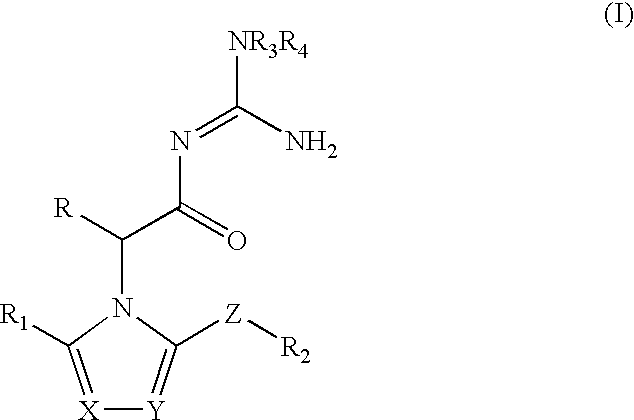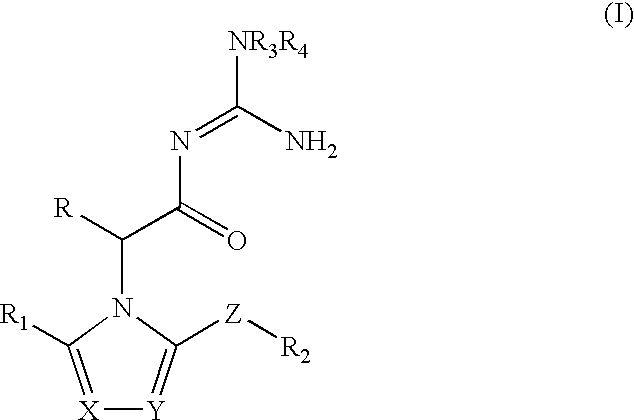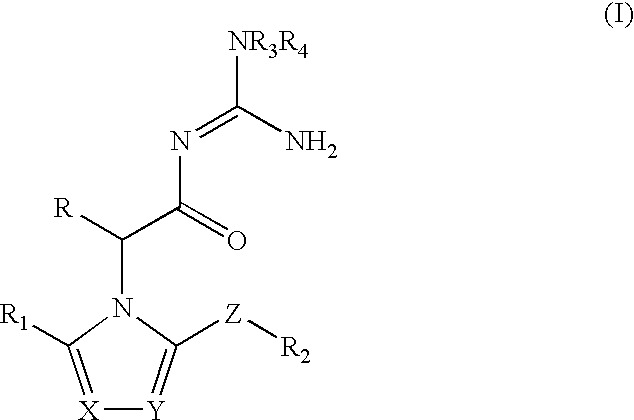Azolylacylguanidines as beta-secretase inhibitors
a beta-secretase and azolylacylguanidine technology, applied in the field of0002amyloid deposits and neurofibrillary tangles, can solve the problems of eventual death and severe impairmen
- Summary
- Abstract
- Description
- Claims
- Application Information
AI Technical Summary
Benefits of technology
Problems solved by technology
Method used
Image
Examples
example 1
Preparation of (N-(diaminomethylene)-2,4-diphenyl-1H-pyrrole-1-acetamide)
[0198]
[0199]Step 1
[0200]A solution of 1,4-diphenyl-butane-1,4-dione (1 eq), glycine (3 eq.) and pTSA (0.05 eq) in ethanol is refluxed for 3 days. The mixture is cooled and the EtOH evaporated in vacuo. The residue is diluted with DCM and washed with NaOH (1 N). The aqueous phase is acidified with conc. HCl and extracted with EtOAc, dried over MgSO4 and concentrated.
[0201]Step 2
[0202]To a solution of (2,5-diphenyl-pyrrol-1-yl)-acetic acid (1 eq.) in DMF is added CDI (1.2 eq.) and the mixture stirred at RT for 1 hour. Then add a solution of guanidine HCl (3 eq.) and triethylamine (3 eq.) in DMF is added. The reaction is stirred for 5 hours, then water is added and the mixture extracted with EtOAc, dried over MgSO4 and concentrated. The residue is dissolved in a mixture of DMSO, MeOH and water (1.5 mL total) and purified by Gilson preparative HPLC system. See Gilson Preparative HPLC conditions: Gilson Preparative ...
examples 2-7
Preparation of Derivatives of (N-(diaminomethylene)-2,4-diphenyl-1H-pyrrole-1-acetamide)
[0203]
[0204]Using essentially the same procedure described in Example 1 and employing the appropriate amino acid, the compounds shown in Table I were prepared and identified by HPLC and mass spectral analyses. HPLC Conditions: HP 1100 HPLC system; Waters Xterra MS C18, 2 mm (i.d.)×50 mm (length), 3.5 μm column, set at 50° C.; Flow rate 1.0 mL / min; Solvent A: 0.02% formic acid in water; Solvent B 0.02% formic acid in ACN; Gradient: Time O: 10% B; 2.5 min 90% B; 3 min 90% B; Sample concentration: ˜2.0 mM; Injection volume: 5 μL; Detection: 220 nm, 254 nm DAD.
[0205]
TABLE IHPLCEx. No.RObserved Ion(min)2n-Pr361 [M + H]2.213i-Bu375 [M + H]2.364CH2CO2H377 [M + H]1.805(CH2)2SCH3393 [M + H]2.1261-naphthyl-methyl459 [M + H]2.457CH2CO2-t-Bu433 [M + H]2.29
examples 8-10
Preparation of 2,5-Dihenylpyrrole Acylguanidine Derivatives
[0206]
[0207]Using essentially the same procedures described in Example 1 and employing the appropriate substituted guanidine in step 2, the compounds shown in Table II were prepared and identified by HPLC and mass spectral analyses. HPLC Conditions: HP 1100 HPLC system; Waters Xterra MS C18, 2 mm (i.d.)×50 mm (length), 3.5 μm column, set at 50° C.; Flow rate 1.0 mL / min; Solvent A: 0.02% formic acid in water; Solvent B 0.02% formic acid in ACN; Gradient: Time O: 10% B; 2.5 min 90% B; 3 min 90% B; Sample concentration: ˜2.0 mM; Injection volume: 5 μL; Detection: 220 nm, 254 nm DAD.
[0208]
TABLE IIEx.ObservedHPLCNo.R3R4Ion(min)8COCH3H361 [M + H]2.699CH2CH2OCH2CH2389 [M + H]2.14104-CH3OC6H4H425 [M + H]2.21
PUM
 Login to View More
Login to View More Abstract
Description
Claims
Application Information
 Login to View More
Login to View More - R&D
- Intellectual Property
- Life Sciences
- Materials
- Tech Scout
- Unparalleled Data Quality
- Higher Quality Content
- 60% Fewer Hallucinations
Browse by: Latest US Patents, China's latest patents, Technical Efficacy Thesaurus, Application Domain, Technology Topic, Popular Technical Reports.
© 2025 PatSnap. All rights reserved.Legal|Privacy policy|Modern Slavery Act Transparency Statement|Sitemap|About US| Contact US: help@patsnap.com



